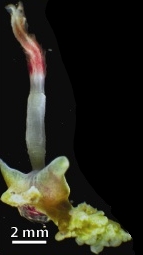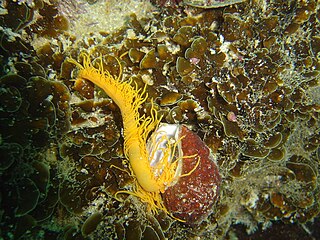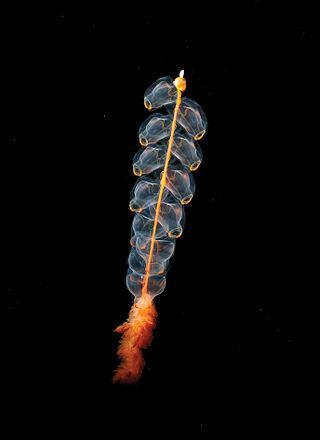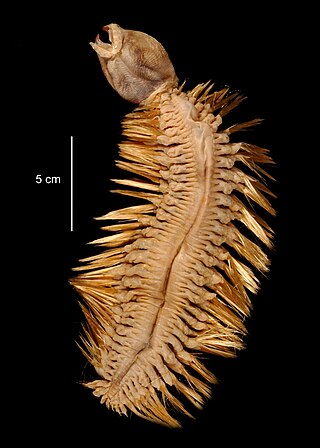
Bioluminescence is the production and emission of light by living organisms. It is a form of chemiluminescence. Bioluminescence occurs widely in marine vertebrates and invertebrates, as well as in some fungi, microorganisms including some bioluminescent bacteria, and terrestrial arthropods such as fireflies. In some animals, the light is bacteriogenic, produced by symbiotic bacteria such as those from the genus Vibrio; in others, it is autogenic, produced by the animals themselves.
The pelagic zone consists of the water column of the open ocean and can be further divided into regions by depth. The word pelagic is derived from Ancient Greek πέλαγος (pélagos) 'open sea'. The pelagic zone can be thought of as an imaginary cylinder or water column between the surface of the sea and the bottom. Conditions in the water column change with depth: pressure increases; temperature and light decrease; salinity, oxygen, micronutrients all change. In a manner analogous to stratification in the Earth's atmosphere, the water column can be divided vertically into up to five different layers, with the number of layers depending on the depth of the water.

Siphonophorae is an order within Hydrozoa, which is a class of marine organisms within the phylum Cnidaria. According to the World Register of Marine Species, the order contains 175 species described thus far.

Osedax is a genus of deep-sea siboglinid polychaetes, commonly called boneworms, zombie worms, or bone-eating worms. Osedax is Latin for "bone-eater". The name alludes to how the worms bore into the bones of whale carcasses to reach enclosed lipids, on which they rely for sustenance. They utilize specialized root tissues for bone-boring. It is possible that multiple species of Osedax reside in the same bone. Osedax worms are also known to feed on the collagen itself by making holes in the whale's skeletal structure. These holes can also serve as a form of protection from nearby predators.
Chaetopterus pugaporcinus, commonly known as the pigbutt worm or flying buttocks, is a species of worm first described by scientists at the Monterey Bay Aquarium Research Institute in 2007. The worm is round in shape, approximately 10 to 20 millimeters in length, and bears a strong resemblance to a disembodied pair of buttocks. Because of this, it was given a Latin species name that roughly translates to "resembling a pig's rear."

Polynoidae is a family of marine Polychaete worms known as "scale worms" due to the scale-like elytra on the dorsal surface. Almost 900 species are currently recognised belonging to 9 subfamilies and 167 genera. They are active hunters, but generally dwell in protected environments such as under stones. The group is widely distributed from shallow intertidal waters to hadal trenches. They are the most diverse group of polychaetes in terms of genus number and second most diverse in terms of species number which is almost 8% of all segmented worm species.

Terebellida make up an order of the Polychaeta class, commonly referred to as "bristle worms". Together with the Sabellida, the Spionida and some enigmatic families of unclear taxonomic relationship, they make up the subclass Canalipalpata, one of the three main clades of polychaetes. Like most polychaetes, almost all members of the Terebellida are marine organisms. Most are small, sessile detritivores which live in small tubes they build from mud or similar substrate, or burrow in the sand. Their central nervous system displays characteristic apomorphies.
Swima bombiviridis is a worm species that lives in the deep ocean. It is also known as the green bomber worm or bombardier worm. This deep ocean pelagic (free-swimming) annelid has modified bioluminescent gills that can be cast off from an individual. These discarded gills somewhat resemble green "bombs" that remain illuminated for several seconds after they have been discarded. It is thought that this is a defensive mechanism rather than reproductive, as it is seen in both mature and juvenile individuals. This species was the first of its genus, Swima, to be discovered, and was the only one with a formal scientific name as of 2010. The genus name, Swima, is derived from the Latin, referring to the animal's ability to swim. The species name, bombiviridis, is derived from the Latin prefix bombus, meaning humming or buzzing, and the suffix viridis, which is Latin for the color green. Swima bombiviridis therefore translates to "swimming green bomber".

Marrus orthocanna is a species of pelagic siphonophore, a colonial animal composed of a complex arrangement of zooids, some of which are polyps and some medusae. Swimming independently in the mid-ocean, it lives in the Arctic and other cold, deep waters. It is a colonial creature that is born from a single egg which is fertilized. Later on, a protozoan forms that eventually grows to form more duplicating members of the colony. It belongs to the order Siphonophorae and the genus Marrus, which also includes M. antarcticus, M. claudanielis, and M. orthocannoides.
Teuthidodrilus samae, dubbed as the squidworm, is a species of acrocirrid marine annelid worms. It is free-swimming and can be found in the deep sea water column at depths of 2,039 to 2,912 m. It feeds on marine snow and can grow to about 9 cm (3.5 in) in length and 1 cm (0.39 in) in width. It is named for the ten squid-like appendages emerging from its head. It was discovered in 2007 in the benthopelagic zone of the Celebes Sea, near the Tawi-Tawi islands of the Philippines. It is the only species in the genus Teuthidodrilus.

Acrocirridae is a family of polychaete worms. Acrocirrids are detritivores, catching falling particles with numerous long prostomial tentacles. There are eight known genera, and at least 21 described species and subspecies within the Acrocirridae. The acrocirrids are primarily benthic (seabed-dwelling) animals, but at least two genera appear to have evolved or adapted to a pelagic (free-swimming) habitat.
Yoda purpurata is a species of acorn worm discovered 2.5 km below the surface of the Atlantic ocean, and was the first of the genus Yoda found. Ranging from 12 to 19 cm in length, it was named after the fictional character Yoda from the Star Wars franchise. It was the first known hermaphroditic member within the phylum. The other known hermaphroditic member of the phylum is Yoda demiankoopi discovered in 2021.
Osedax japonicus is a species of bathypelagic polychaete tube worm that lives at great depths on the seabed and is able to sustain itself on the bones of a dead whale. It was first described in 2006 from a sunken sperm whale carcase near Kyushu, Japan.

Eulagisca gigantea is a species of scale worm. This species is specifically found in the deep-sea in cold waters like the Antarctic Ocean. The scale worms are named for the elytra on their surface that look like scales.

Karen Joyce Osborn is a marine scientist at the Smithsonian's National Museum of Natural History Invertebrate Zoology department. She is known for her work in marine biology specializing in mid-water invertebrates.
Eukrohnia fowleri is a deep-sea marine arrow worm. It is the only known bioluminescent member of the genus Eukrohnia, and one of the two known species of bioluminescent arrow worms, the other being the distantly related Caecosagitta macrocephala. The bioluminescent organ of Eukrohnia fowleri is found along the center of its tail fin on both its dorsal and ventral side. It has a secreted bioluminescence that is thought to be coelenterazine based. While both species use luciferases in conjunction with coelenterazine for light emission, the luciferase of Eukrohnia fowleri is highly stable after 30 minutes while the luciferase of Caecosagitta macrocephala becomes inactive. So far, there is no other bioluminescent organism that uses hexagonal packing in order to hold bioluminescent materials/ E. fowleri evolved through the adaptation to hypoxic water and due to the recent oxygenation of water they have been experiencing bottleneck events. These events have been seen as one of the reasons that E. fowleri have such low biodiversity.
Caecosagitta macrocephala is a deep sea marine chaetognath that is distributed in meso- and bathypelagic layers. It has a very wide distribution that ranges from the Subantarctic to Subarctic Ocean. Cecosagitta macrocephalas have large heads, hence their name “macro-cephala”. Within their eyes are photoreceptive regions that allow them to catch weak light at bathypelagic depths. Along with their eyes, their gut or intestine has orange pigmentation and a luminous organ that gleams due to bioluminescence unlike some other species of Sagittidae. To be more precise, the luminescent organ is located on the ventral edge of each anterior lateral fin. It is the only member of the genus Caecosagitta, and only one of the two known species of bioluminescent chaetognath, the other being the distantly related Eukrohnia fowleri. C. macrocephala has a secreted bioluminescence that is thought to be coelenterazine based. The luciferase is highly unstable, being unable to survive a single freeze-thaw, and is rapidly inactivated at ice-cold temperatures.

Tomopteridae is a family of holopelagic polychaetes belonging to the order Phyllodocida. The genus Tomopteris consist of about 70 species, and the three other genera of one known species each. Length varies from just 1-2 cm to 30 cm. These are very active swimmers, and have some of the highest metabolic rate among annelids. To increase buoyancy they have a large body cavity (coelom) filled with body fluid of a density similar to seawater. With the coelom taking up much of the inner space, the muscular system has been reduced to a mesh just below the epidermis. The circulatory system has been lost, and the coelomic fluid has taken over the role of transporting oxygen, nutrients and gametes. Instead of a heart the inner surface of the worm is covered with cilia that moves the fluid around inside the body. The absence of septa between the segments makes the circulation more efficient. A series of extretory organs called metanephridia consists of ciliated funnels which opens to the coleomic cavity and connects with the exterior though a nephridiopore. Some species are bioluminescent, and produce a yellow light.

Buskiella is a genus of pelagic polychaete annelids placed either in the family Flotidae or Flabelligeridae. In appearance, they are generally bluish or yellowish, depending on lighting conditions, and live exclusively in very deep water. They move by swinging their bodies from side to side, "rowing with [their] bristles." Species have nine to eleven chaetigers.










